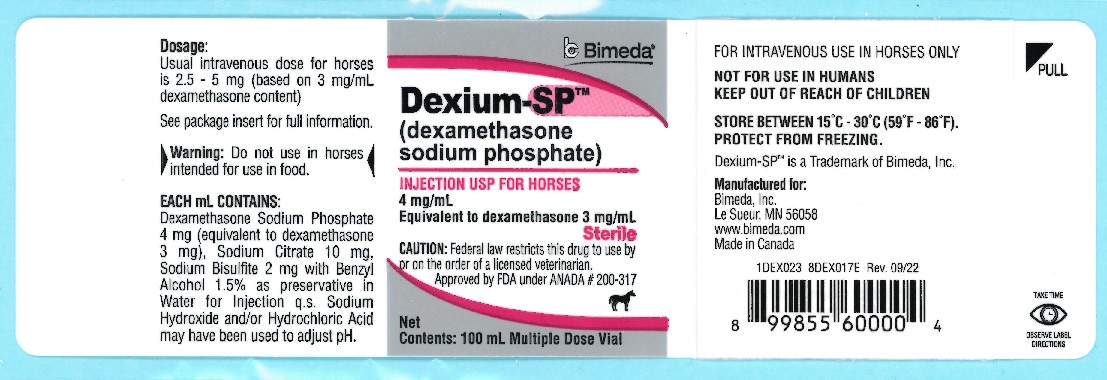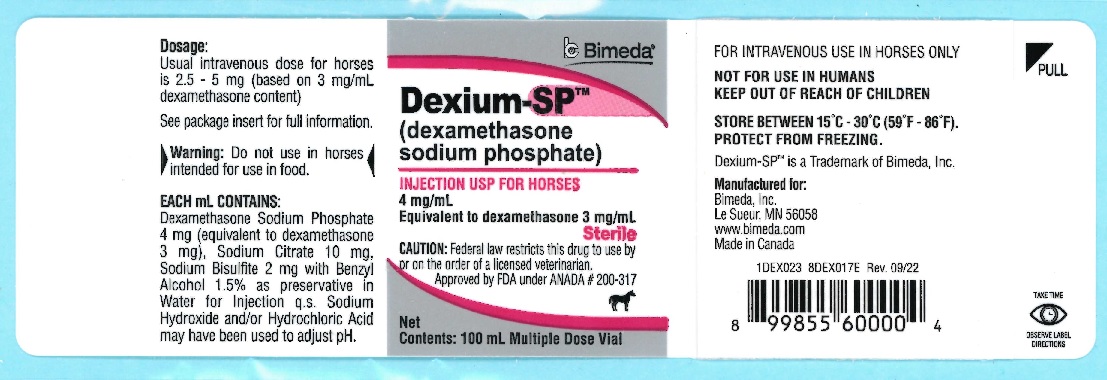Label: DEXIUM-SP- dexamethasone sodium phosphate injection, solution
- NDC Code(s): 61133-0892-9
- Packager: Bimeda, Inc.
- Category: PRESCRIPTION ANIMAL DRUG LABEL
Drug Label Information
Updated March 27, 2024
If you are a healthcare professional or from the pharmaceutical industry please visit this version.
- Download DRUG LABEL INFO: PDF XML
- Official Label (Printer Friendly)
-
DESCRIPTION
Dexamethasone-SP
(dexamethasone sodium phosphate)
INJECTION USP FOR HORSES
4 mg/mL
Equivalent to dexamethasone 3 mg/mL
FOR INTRAVENOUS USE IN HORSES ONLY
NOT FOR USE IN HUMANS
KEEP OUT OF REACH OF CHILDREN
WARNING: DO NOT USE IN HORSES INTENDED FOR FOODCAUTION:
Federal law restricts this drug to use by or on the order of a licensed veterinarian.DESCRIPTION:
Dexamethasone sodium phosphate (a synthetic adrenocortical steroid), is a white or slightly yellow crystalline powder. It is freely soluble in water and is exceedingly hygroscopic.Each mL of Dexamethasone-SP (dexamethasone sodium phosphate) contains Dexamethasone Sodium Phosphate 4 mg (equivalent to dexamethasone 3 mg), Sodium Citrate 10 mg, Sodium Bisulfite 2 mg, Benzyl Alcohol 1.5% as a preservative, in Water for Injection q.s. Sodium Hydroxide and/or Hydrochloric Acid to adjust pH to between 7.0 and 8.5.
-
CLINICAL PHARMACOLOGY
CLINICAL PHARMACOLOGY:
Dexamethasone is a synthetic corticosteroid and possesses glucocorticoid activity.Dexamethasone sodium phosphate is a salt of dexamethasone that is particularly suitable for intravenous administration because it is highly water soluble, permitting administration of relatively large doses in a small volume of diluent.
Dexamethasone, as a steroid, is equivalent in potency to some established steroids while being considerably more potent than others. In the case of the dog, dexamethasone is found to be about equivalent in dosage to prednisone but about 30 to 40 times more potent than prednisolone.
- INDICATIONS & USAGE
-
CONTRAINDICATIONS
CONTRAINDICATIONS:
Do not use in viral infections. Except when used for emergency therapy, dexamethasone sodium phosphate is contraindicated in animals with tuberculosis and chronic nephritis. Existence of congestive heart failure, osteoporosis and diabetes are relative contraindications.In the presence of infection appropriate antibacterial agents should also be administered and should be continued for at least 3 days after discontinuance of the hormone and disappearance of all signs of infection.
-
WARNINGS
WARNINGS:
Clinical and experimental data have demonstrated that corticosteroids administered orally or by injection to animals may induce the first stage of parturition if used during the last trimester of pregnancy and may precipitate premature parturition followed by dystocia, fetal death, retained placenta and metritis.Additionally, corticosteroids administered to dogs, rabbits, and rodents during pregnancy have produced cleft palate. Other congenital anomalies including deformed forelegs, phocomelia, and anasarca have been reported in offspring of dogs which received corticosteroids during pregnancy.
-
PRECAUTIONS
PRECAUTIONS:
Because of the anti-inflammatory action of corticosteroids, signs of infection may be hidden and it may be necessary to stop treatment until diagnosis is made. Overdosage of some glucocorticoids may result in sodium retention, fluid retention, potassium loss and weight gains.In infections characterized by overwhelming toxicity, dexamethasone sodium phosphate therapy, in conjunction with indicated antibacterial therapy, is effective in reducing mortality. It is essential that the causative organism be known and an effective antibacterial agent be administered concurrently. The injudicious use of adrenal hormones in animals with infections can be hazardous.
Use of corticosteroids, depending on dose, duration and specific steroid, may result in inhibition of endogenous steroid production following drug withdrawal. In patients presently receiving or recently withdrawn from systemic corticosteroid treatments, therapy with a rapidly acting corticosteroid should be considered in unusually stressful situations.
-
ADVERSE REACTIONS
ADVERSE REACTIONS:
The therapeutic use of dexamethasone sodium phosphate injection is unlikely to cause undesired accentuation of metabolic effects. However, if continued corticosteroid therapy is anticipated, a high protein intake should be provided to keep the animal in positive nitrogen balance. A retardant effect on wound healing should be considered when it is used in conjunction with surgery. Euphoria or an improvement of attitude, and increased appetite are the usual manifestations.Side effects such as glycosuria, hyperglycemia, diarrhea, polydipsia and polyuria have been observed in some species.
Side effects such as SAP and SGPT enzyme elevations, eosinopenia, and vomiting have occurred following use of synthetic corticosteroids in dogs.
Cushing's Syndrome in dogs has been reported in association with prolonged or repeated steroid therapy.
Corticosteroids reportedly cause laminitis in horses.
To report suspected adverse events, for technical assistance or to obtain a copy of the Safety Data Sheet (SDS), contact Bimeda, Inc. at 1-888-524-6332. For additional information about adverse drug experience reporting for animal drugs, contact FDA at 1-888-FDA-VETS or online at https://www.fda.gov/reportanimalae.
-
DOSAGE & ADMINISTRATION
DOSAGE AND ADMINISTRATION:
For Intravenous Use Only.
Horses: The usual intravenous dosage is 2.5 to 5 mg (based on 3 mg per mL of dexamethasone content).If permanent corticosteroid effect is required, oral therapy with dexamethasone may be substituted. When therapy is to be withdrawn after prolonged corticosteroid administration, the daily dose should be reduced gradually over a number of days, in stepwise fashion.
- HOW SUPPLIED
- STORAGE AND HANDLING
- PRINCIPAL DISPLAY PANEL
-
INGREDIENTS AND APPEARANCE
DEXIUM-SP
dexamethasone sodium phosphate injection, solutionProduct Information Product Type PRESCRIPTION ANIMAL DRUG Item Code (Source) NDC:61133-0892 Route of Administration INTRAVENOUS Active Ingredient/Active Moiety Ingredient Name Basis of Strength Strength DEXAMETHASONE SODIUM PHOSPHATE (UNII: AI9376Y64P) (DEXAMETHASONE - UNII:7S5I7G3JQL) DEXAMETHASONE 3 mg in 1 mL Packaging # Item Code Package Description Marketing Start Date Marketing End Date 1 NDC:61133-0892-9 100 mL in 1 VIAL, MULTI-DOSE Marketing Information Marketing Category Application Number or Monograph Citation Marketing Start Date Marketing End Date ANADA ANADA200317 04/04/2009 Labeler - Bimeda, Inc. (060492923) Registrant - Bimeda, Inc. (060492923) Establishment Name Address ID/FEI Business Operations Bimeda-MTC Animal Health 256232216 manufacture


